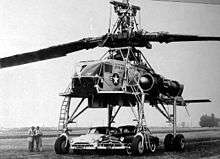Hughes XH-17
| XH-17 "Flying Crane" | |
|---|---|
 | |
| Role | Helicopter |
| Manufacturer | Hughes Helicopters |
| First flight | 23 October 1952 |
| Retired | December 1955 |
| Status | Scrapped |
| Number built | 1 |
|
| |
The Hughes XH-17 "Flying Crane" was the first helicopter project for the helicopter division of Hughes Aircraft. The XH-17, which had a two-bladed main rotor system with a diameter of 134 feet (41 m), was capable of flying at a gross weight of more than 50,000 pounds (23,000 kg).
Design and development
The XH-17 was a heavy-lift rotorcraft that was designed to lift loads in excess of 15 metric tons. To speed construction, parts of the XH-17 were scavenged from other aircraft. The front wheels came from a B-25 Mitchell and the rear wheels from a C-54 Skymaster. The fuel tank was a bomb bay-mounted unit from a B-29 Superfortress. The cockpit was from a Waco CG-15 and the tail rotor from a Sikorsky H-19 was used for yaw control.
In the late 1940s, Hughes developed an interest in helicopters. In August 1947, helicopter manufacturer Kellett sold his design for the giant XH-17 Sky Crane to Hughes, who commissioned the development of the XH-17 Flying Crane research vehicle. In 1948, the XH-17 began to take shape. The giant helicopter was tested in Culver City, California over a three-year period beginning in 1952. The XH-17 flew in 1953 at a gross weight in excess of 50,000 pounds (23,000 kg). It still holds the record for flying with the world's largest rotor system. Only one unit was built, since the aircraft was too cumbersome and inefficient to warrant further development.

The propulsion system was unusual. Two General Electric J35 turbojet engines were used, sending bleed air up through the rotor hub. The blades were hollow, and the hot compressed air traveled through the blades to tip jets where fuel was injected. In flight, the rotors spun at a sedate 88 rpm. Since the rotor was driven at the tips rather than the hub, little torque compensation was required. Thus, the XH-17 had a very small tail rotor compared to its main rotor. This drive system was inefficient, limiting the test aircraft to a range of only 40 miles (64 km).
The XH-28 was a derivative, with a maximum weight of 104,000 pounds (47,000 kg). Though a wooden mockup of the design was made, the program was canceled and none were built.
Specifications
General characteristics
- Crew: 3 (pilot, mechanic and in-flight test engineer)
- Length: 53 ft 3 in (16.25 m)
- Rotor diameter: 129 ft 11 in (39.62 m)
- Height: 30 ft 2 in (9.17 m)
- Empty weight: 28,563 lb (12,956 kg)
- Useful load: 10,284 lb (4,665 kg)
- Loaded weight: 31,270 lb (14,184 kg)
- Max. takeoff weight: 43,500 lb (19,731 kg)
- Powerplant: 2 × General Electric J35 turbojets
Performance
- Maximum speed: 90 mph (145 km/h)
- Cruise speed: 85 mph (137 km/h)
- Range: 40 mi (64 km)
- Service ceiling: 13,100 ft (3,995 m)
- Rate of climb: 1650 ft/min (8.4 m/s)
- Disc loading: 2.34 lb/ft² (11.5 kg/m²)
See also
- Aircraft of comparable role, configuration and era
References
- Jim Winchester The World's Worst Aircraft, 2005
- Rene J. Francillon McDonnell Douglas Aircraft since 1920: Volume II, 1997
External links
| Wikimedia Commons has media related to Hughes XH-17. |
- "Giant Jet Helicopter Read For First Flight." Popular Mechanics, August 1952, p. 116.
- http://www.1000aircraftphotos.com/Contributions/VanTilborg/3138.htm
- http://findarticles.com/p/articles/mi_qa3897/is_200104/ai_n8943768
- http://www.flightglobal.com/pdfarchive/view/1956/1956%20-%200015.html